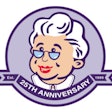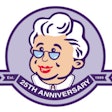
Editor's note: As part of the celebration of AuntMinnie.com's upcoming 25th anniversary, we're presenting 25 for 25 -- a series featuring our most popular content for each of the last 25 years. New articles will be published each Monday until our official anniversary at RSNA 2024. Our top article in 2010 was a follow-up of our most highly viewed article in 2009.
SACRAMENTO, CA - A California radiologic technologist accused of delivering a major radiation overdose to a 23-month-old boy faced testimony this week on her role in the incident. Witnesses who spoke at a hearing on revoking the technologist's license said they still don't understand how the boy received 151 CT scans in just over an hour.
In January 2008, 23-month-old Jacoby Roth fell out of bed, and when he could hardly move his head his worried parents took him to the emergency room at Mad River Community Hospital in Arcata, a small town 290 miles north of San Francisco.
There, a doctor ordered x-rays and CT scans to check for damage to the child's cervical spine. He was taken to the scanning room, where radiologic technologist Raven Knickerbocker performed CT scans at C-spine levels C1 through C4 in the same section of the midmaxillary sinuses, midclivus, and posterior fossa.
Over the next 68 minutes, the toddler was exposed to 151 scans.
Radiation overdose
The incident was recalled this week in two days of hearings held by the California Department of Public Health (CDPH) on whether to revoke Knickerbocker's radiologic technologist license.
In testimony before an administrative law judge, the boy's father, who during the scans was standing at the foot of the CT table to calm his son, recalled his growing concern as the scanning stretched on. "I said, 'Stop this!' " Padre Roth recalled, noting that Knickerbocker finally stopped the scan only after he became angry.
 |
| Jacoby Roth several hours after receiving 151 CT scans in a 68-minute period. Image courtesy of Roth family attorney Don Stockett. |
Within a few hours, the child developed a bright red ring around his head from the massive overdose of radiation. Photographs of the left side of the boy's face show a clear line extending from the infraorbital ridge backward through the ear and nape of the neck; a similar line extends from the infraorbital ridge through the ear on the right side.
In off-the-record comments, some state officials called it the worst case of radiation overdose of a child in the U.S.
The boy's mother, Carrie Roth, recalled questioning the necessity of the scans and was concerned about radiation because her son had already had a CT scan when he was younger. "Is this safe?" she remembered asking doctors when she was told her son needed yet another CT scan because he had moved during the scans done by Knickerbocker.
Padre Roth asked how that could be, noting that his son was in a papoose board restraint and was asleep for most of the first scanning session.
"I had a bad feeling," he testified. "I knew something was wrong; there's no way a CT scan is going to take an hour and 20 minutes. I should have stopped it sooner."
"I started crying," the boy's mother recalled. "What happened the first time?" she asked the doctor, referring to the first lengthy scan.
Carrie Roth described seeing Knickerbocker "push the [scanner] button many times, about every 30 seconds."
Scanner records show an average interval of 25 seconds between the 151 scans, which started at 8:29 a.m. on January 23, 2008, and ended at 9:37 a.m. The CT scanner used was a single-slice Picker PQ-5000 manufactured in 1998, which needed about 25 seconds for the tubes to cool between scans. It was replaced a month after the incident, but hospital officials said the replacement had been planned long before and was unrelated.
A second CT scan by radiologic technologist Susan Sampson took only two minutes and included 25 axial slices. Sampson remembered being "a little shocked" when she heard that Knickerbocker had done 151 scans in the same area at the base of the boy's skull. "That's a lot more time than it usually takes for an exam," she testified, estimating it should have taken less than 10 minutes.
Knickerbocker showed little emotion during the hearing but became teary when a former supervisor said she had been a good employee before the incident. She did not testify during the hearing.
Bruce Fleck, the hospital's former radiology manager, testified that Knickerbocker subsequently gave many explanations for the incident, such as the boy's parents distracted her, the scanning table wouldn't move incrementally, and the boy's father was leaning on the table. But he noted that an experienced operator like Knickerbocker should have known to stop after a couple of images if the scanner wasn't operating properly.
When asked if the scanner could somehow take images automatically, he replied that the images showed the machine was in manual axial mode. "She had to hit the button each time," Fleck observed.
He also noted that Sampson had no problems when she used the machine. It was checked later and no malfunctions were found.
Knickerbocker could not provide a "valid explanation" of why she took 151 images of the same location, Fleck said. "I think it was just a rogue act of insanity," he told a stunned court.
“I think it was just a rogue act of insanity.”— Bruce Fleck, former radiology manager, Mad River Community Hospital
Dave Laumann, the head technologist at the time, said Knickerbocker told him she didn't know 151 scans had been taken. "It just seemed to me that she wasn't dealing with it," he testified.
Fleck was so upset by what he called Knickerbocker's "egregious ethical breach" that he wrote to the American Registry of Radiologic Technologists (AART) about the incident. Many of the hospital's radiology staff said Knickerbocker violated ALARA (as low as reasonably achievable) standards by doing such a lengthy scan.
A report by the hospital's medical physicist calculated that the boy's absorbed radiation dose was 2.8 Gy (2,800 mSv) and possibly as high as 11 Gy (11,000 mSv). The dose the boy received compares with a range of 1.5 to 4.0 mSv for a normal pediatric CT study of the entire spine, according to pediatric imaging experts.
Using relevant material from the article "Estimated Risks of Radiation-Induced Fatal Cancer from Pediatric CT," published in the American Journal of Roentgenology (February 2001, Vol. 176:2, pp. 289-296), a report by the hospital's medical physicist concluded the child had a lifetime increased risk of a fatal cancer of 39%.
State investigators who interviewed Knickerbocker said she told them that she only pushed the scanner button two or three times, and could not explain why the machine took so many scans.
Mindy Malone, a CDPH health physicist who investigated the incident, said Knickerbocker called for help during the scanning session but never got any. But Laumann said he came into the room shortly after the scanning began to check on the procedure, contradicting Knickerbocker's assertions.
Wesley Root, MD, the hospital's head of radiology, said a scanner check showed that Knickerbocker had plotted only the beginning slice for the exam, meaning the machine would automatically stop after one slice, Malone testified.
"It did one scan at a time," Malone testified. "She had to manually make the exposure every time."
Root also noted that the red light over the scanner's gantry flashes each time a scan is done, casting doubt on Knickerbocker's statements that she wasn't aware that 151 scans had been acquired.
Suspended license
Mad River fired Knickerbocker two weeks after the incident; the CDPH suspended her license nine months later. The CDPH determined that "operator error" by Knickerbocker caused the radiation overdose and fined Mad River $25,000, noting that the hospital failed to follow its policies and procedures for radiation safety. Knickerbocker gave inconsistent explanations about the incident, state officials found.
The Roth family's attorney, Don Stockett of Folsom, CA, has filed a lawsuit against the hospital and Knickerbocker, claiming negligence and medical battery. Stockett said he sent a blood sample from Jacoby Roth for analysis to David Lloyd, MD, a DNA specialist and principal investigator of the Molecular Design Group of the School of Biochemistry and Immunology at Trinity College in Dublin, Ireland. The analysis found that Roth sustained substantial chromosomal damage, Stockett said.
Knickerbocker had been expected to testify at the Sacramento hearing, but because the testimony ran long, the hearing has been continued until a future date yet to be scheduled.
Padre Roth said Knickerbocker should lose her license for good. "We're still worried about the long-term effects on our son," he said. "She should never be allowed near anyone's children again."



















